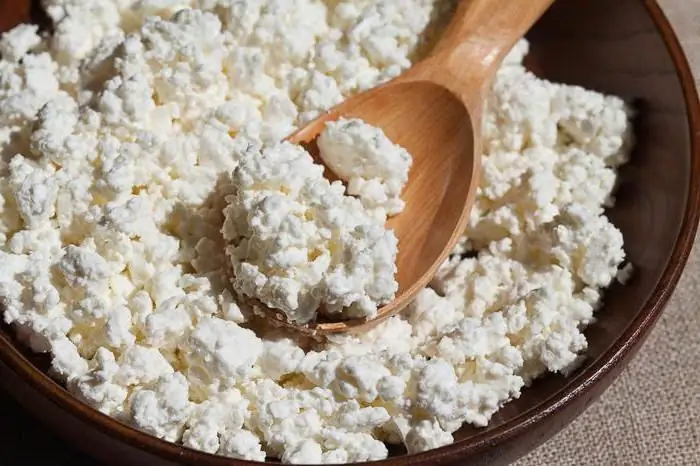2025 Author: Isabella Gilson | [email protected]. Last modified: 2025-01-23 12:50:46
Once the eastern city of Prussia, Tilsit (now the Kaliningrad region) is most famous for the fact that in 1807 a peace treaty was signed here between Emperor Napoleon and Alexander the First. But for many people, especially gourmets, there is another historical fact that is attributed to this city. It is a semi-hard Tilsiter cheese that originated in this area.
What is Tilsiter?
Cheese production in East Prussia dates back to the time of the Teutonic Knights. A real boom in cheese making in these lands occurred at the very beginning of the 18th century, after the so-called Great Plague. At that time, Mennonite settlers from Holland, Salzburg and Switzerland flooded these lands, who brought their cheese-making traditions.
As a result, the production of cheese in East Prussia was put on a grand scale, in particular, Mennonite cheese was very popular, which was sold in significant quantities.
The recipe for the future famous Tilsiter cheese was based on the "homemade recipes" of peasants from the districts of Tilsit, Elkhniderung and Ragnit. But the industrial production of a product that would later conquer all of Europe beganmany years later in 1840.

Tilsiter cheese is a semi-hard cheese whose recipe and taste have changed over time. In accordance with current modern standards, it must be made from cow or buffalo milk (or a mixture of both). The production does not use forced pressing, only natural aging at a temperature of 10-16°C for at least three weeks.
The color of the finished product is light yellow, the state is solid, with holes of various sizes. This cheese has a brown rind. Tilsiter's recipe allows the use of spices that expand the flavor palette, so cumin or black pepper is often included in its composition.
Tilsiter cheese is not a registered trademark and is therefore produced in several European countries. An exception is the Swiss Tilsiter. This cheese is trademarked.

Taste is the key to popularity
Thanks to its unique taste and inimitable aroma, Tilsiter was inscribed in the "Golden Fund" of cheese making, which includes all the most famous types of cheeses. Relatively little time has passed since the start of production on an industrial scale, but Tilsiter cheese quickly earned respect among both gourmets and ordinary lovers of this product.
The flavor and aroma characteristics of this cheese pair perfectly with rye bread and dark beers. Tilsiter refers to table products, which means that it can beuse as a snack on its own, as well as with vegetables, for baking or as part of a sauce.

Tilsiter cheese: ingredients
The main ingredient of Tilsiter, however, like most cheeses, is whole or pasteurized milk. a product made on the basis of raw milk is marked in red on the packaging. It has a richer aroma and taste.
Green marking on the package means that pasteurized milk was used in the manufacture. The taste of such cheese is softer.
Yellow marking means that the base of the cheese is a mixture of pasteurized milk and cream. Cheese is obtained with a rich aroma and spicy taste.
Tilsiter cheese, whose calorie content primarily depends on its variety, has the following energy ratio (proteins / fats / carbohydrates): 29% / 69% / 2%. Fat content varies from 30% to 60%. The average calorie content of Tilsiter is 340 kcal.

Tilsiter cheese: reviews
Cheese, which has gained popularity throughout Europe in a relatively short period of time, must have all the necessary properties. Most often, consumers note the mild taste of Tilsiter cheese, moderate salinity and pleasant aroma. Availability is an important factor. Cheese melts well and is therefore used in many dishes.
Besides this, the advantage of Tilsiter cheese is its strict recipe, which excludes any food additives even with modern production. It's a pledgehigh quality and preservation in cheese of all vitamins and nutrients that are presented in this product: B12, B6, B9, B2, and rare for cheeses B5, A, PP, E, and C.
Recommended:
Cod fish: benefits and harms, calories, composition of vitamins and minerals, nutritional value and chemical composition. How to cook delicious cod

This article will tell you about what is included in the chemical composition of cod, what benefits it brings to human he alth, and also in what cases it should not be consumed. There will also be presented several recipes for cooking cod in the oven, in a pan, in the form of fish soup, etc
Fat-free cottage cheese: calories per 100 grams. Cottage cheese with sour cream: calories per 100 grams. Vareniki with cottage cheese: calories per 100 grams

Cottage cheese refers to fermented milk products, has a low calorie content and is obtained by oxidizing milk, followed by decanting whey. According to the calorie content, it is divided into fat-free cottage cheese (calorie content per 100 g - 70%, fat content up to 1.8%), fat cottage cheese (19 - 23%) and classic (4 - 18%). There are many recipes for dishes with the addition of this product
Chechil (cheese). Smoked cheese "pigtail". Caucasian diet cheese

Tight braids, woven from elastic cheese mass, rightfully lie on store shelves next to other cheeses. Chechil - pickled cheese, the brother of Suluguni, but has its own individual delicate taste
What is the use of cottage cheese? Chemical composition and nutritional value of cottage cheese

Properly selected or cooked cottage cheese will bring much more benefits to the body than the product that is hastily selected or made incorrectly. It turns out that this also requires knowledge, because knowledge is power
Cheese with casu marzu worms. Cheese with cheese fly larvae

It is believed that the most unusual and strange dishes are prepared only in exotic countries. But it's not. For example, in Italy blue cheese is considered a delicacy. However, compared to other dairy products, it will seem like just flowers. A more disgusting product is cheese with worms. No, he's not corrupted. It is specially prepared and eaten with great pleasure

